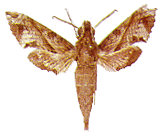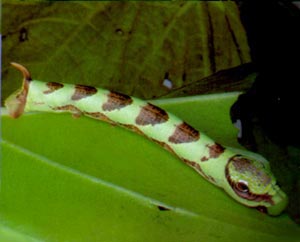|
Panacra mydon Walker
Panacra mydon Walker, 1856, List Specimens lepid. Insects Colln. Br. Mus.,
8: 155.
Panacra mydon Walker; Rothschild & Jordan, 1903: 542.
Thyreus elegantulus Herrich-Schaffer, 1856, Samml. ausser. Schmett., f.
479.
|

Panacra mydon
(.90
natural size)
|

Panacra
mydon (Sphingidae); Hong Kong (M.J. Bascombe)
|
Diagnosis. This species is more strongly variegated than the rest,
distinguished most readily by an oblique, straight, dark band just basal
to the postmedial series of fasciae, and by a dark brown triangular area
at the margin, centred on its very weak central angle.
Taxonomic notes. Sundanian material is referable to ssp. elegantulus.
Geographical range. Oriental tropics to Philippines, Sulawesi and
Sumba,
Habitat preference. The species has only been taken in the lowlands and
would appear to be uncommon.
Biology. The larva of the typical Indian race was described and
illustrated by Bell & Scott (1937). Early instars are pale, yellowish
green, the ocelli on A1 usually developed. The final instar is pale
yellowish green. The oval ocelli are blackish above, reddish brown with
white edging below, all ringed black. The ocelli are contained in a broad
subdorsal stripe that runs from T1 to behind the ocellus then over
dorsally to join with the opposite one. The enclosed dorsal section is
darker green, striped paler. Each abdominal segment has a large, dorsal,
irregular crescent of brown, concave towards the posterior. There is an
irregular lateral brown band over the same segments, narrower at the
spiracles. The horn is orange. Development of the dorsal crescents may
depend on light intensity; they are sometimes weak or absent.
In Java (Dupont & Roepke, 1941) there are two forms of the larva,
green to yellow or brown or black, each variable in marking. The former
usually have a brown dorsal line and a horseshoe-like dorsolateral line
enclosing the ocelli as in the Indian race. The brown lateral line is
present in yellow variants but there is no mention of dorsal patches. The
darker variants have the ocelli in a horseshoe thoracic marking also; on
each abdominal segment there are four white or yellow spots dorsally. The
larva from Hong Kong illustrated in Plate 19 corresponds in
characteristics with that from India.
Recorded host-plants (Bell & Scott; Dupont & Roepke, 1937; Yunus
& Ho, 1980; Barlow, 1982; CIE records; Bascombe, in litt.) are:
Alocasia, Amorphophallus, Arisaema, Caladium, Colocasia, Dieffenbachia,
Homalonema (Araceae); Vitis (Vitidaceae).
<<Back
>>Forward <<Return
to Contents page
|

